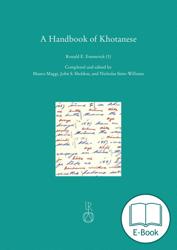Ronald E. Emmerick’s Handbook of Khotanese consists of two parts: his Introduction to Khotanese, tried and tested with students over the years and here made available in print for the first time; and a systematic survey of Khotanese and the closely related Tumshuqese language. The Introduction, completed with additional chapters by the editors, offers a gradual and comprehensive introduction to Old Khotanese, with translation exercises. Late Khotanese is introduced in the final chapter of the course.
Ronald E. Emmerick’s Handbook of Khotanese consists of two parts: an Introduction to Khotanese, and a systematic survey of Khotanese and the closely related Tumshuqese language. His tried and tested Introduction to Khotanese, which has been used by many students over the years, is here made available in print for the first time. Now completed with additional chapters by the editors, it offers a gradual and comprehensive introduction to the writing system and grammar of Old Khotanese, with translation exercises largely based on excerpts from genuine Khotanese texts. A key to the exercises is provided so that the course can be used without a teacher. Though primarily designed as a textbook, the course contains much information concerning Khotanese grammar that is not available elsewhere, accounts for the Buddhist technical vocabulary largely of Indian origin that is not covered in other reference works, and includes a glossary and detailed indexes so that it can also be used as a reference grammar and a basic dictionary. Late Khotanese is introduced in the final chapter of the course. Given the large number of Indian loanwords in Khotanese, the Sanskrit equivalents are given for all Indian loanwords with indication of the immediate source languages—Sanskrit, Prakrit, or Gāndhārī—where their phonology allows identification of a specific source. Emmerick’s systematic survey of Khotanese and Tumshuqese, previously published in abbreviated form in 2009 and here expanded by the editors, forms the second part of this Handbook and includes a chapter on syntax which for the first time deals in some detail with the complex sentence and subordinate clauses. The final bibliography serves as documentation for both parts of the book and provides a starting point for further reading.
All in all, Emmerick’s Handbook of Khotanese offers an up-to-date treatment of the language, which makes free use of historical and descriptive methodology according as the one or the other seems to be of pedagogical advantage. It will be of interest and value to students not only of Iranian philology and linguistics, but also of other academic disciplines such as Indo-European and Indo-Aryan linguistics, Central Asian studies, and Buddhist philology.
Ronald Eric Emmerick (Sydney, 9 March 1937 – Hamburg, 31 August 2001) completed his doctorate at the University of Cambridge (1965) and was professor of Iranian philology at the University of Hamburg (1971–2001). Before 1971 he had worked at the universities of London (School of Oriental and African Studies), Cambridge (Research Fellow of St. John’s College), Chicago (Oriental Institute), and Sydney (Department of Latin). He was elected a corresponding fellow of the British Academy and a corresponding member of the former Istituto Italiano per il Medio ed Estremo Oriente (1990), a corresponding member of the Österreichische Akademie der Wissenschaften (1997), and an honorary fellow of the Australian Academy of the Humanities (1999). In addition to numerous articles in academic journals, he authored the following books: Tibetan texts concerning Khotan (1967); Saka grammatical studies (1968); The Book of Zambasta, a Khotanese poem on Buddhism (1968); The Sutra of Golden Light (1970, 2nd ed. 1990, 3rd ed. 1996); The Khotanese Śūraṅgamasamādhisūtra (1970); Saka documents VI (1971) and VI (1973); A guide to the literature of Khotan (1979, 2nd ed. 1992); The Siddhasāra of Ravigupta, vol. 1 (1980), vol. 2 (1982); The Tumshuqese Karmavācanā Text (1985); Studies in the vocabulary of Khotanese, vol. 1 (1982), vol. 2 (1987), vol. 3 (1997), all with Prods O. Skjærvø; A Chinese text in Central Asian Brahmi script, with Edwin G. Pulleyblank; Saka documents VII: The St. Petersburg collections (1993), and Saka documents text volume III: the St. Petersburg collections (1995), both with Margarita I. Vorob’ëva-Desjatovskaja.
The series Beiträge zur Iranistik was founded in the 1960s by Georges Redard and subsequently edited by Nicholas Sims-Williams from 1997 to 2020; the present series editor is Agnes Korn.
The series publishes works on the languages of the Iranian branch of Indo-European. The focus is on linguistics, including grammars, dictionaries, text editions, philology as well as diachronic and synchronic studies of linguistic topics. Neighbouring fields such as literature, archaeology and anthropology are likewise represented. The languages of the series are English, German and French. The Beiträge zur Iranistik are represented in libraries internationally and are widely used standard works of Iranian studies.


 Sample
Sample